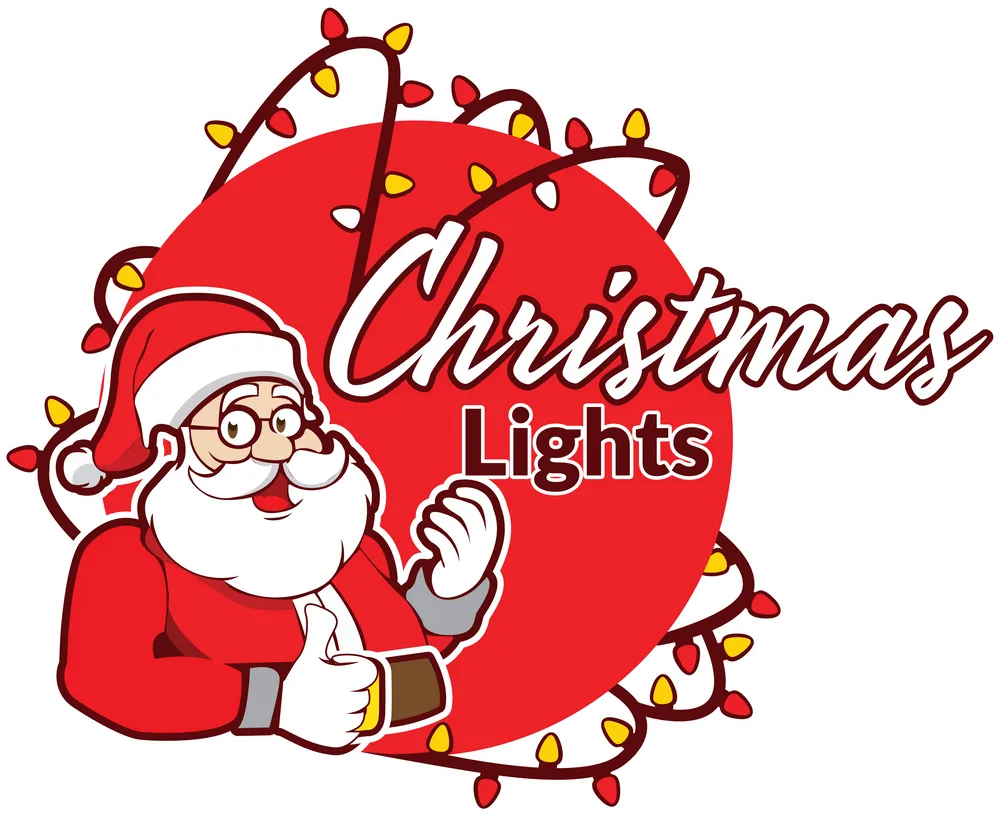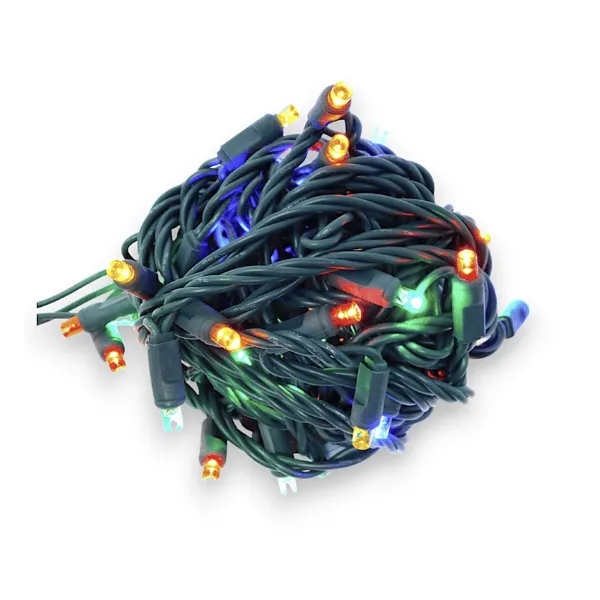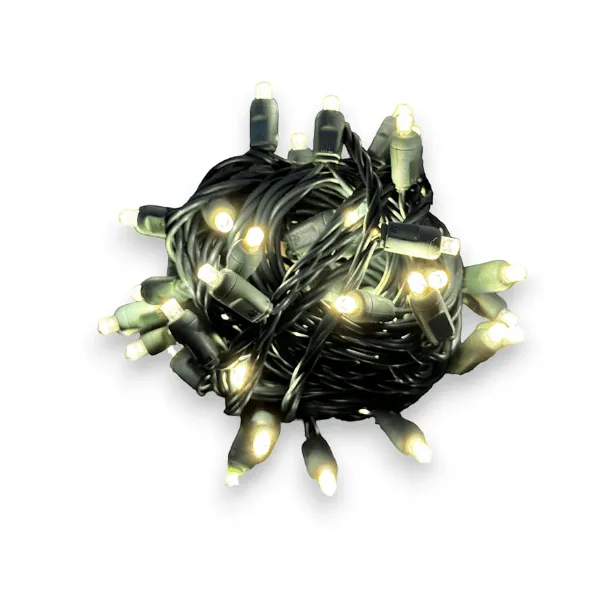Wholesale Pricing Presale Christmas Lights Minis
Pre-Season 50L 6" Spacing 5mm LED Mini Lights (Concave) 24/Case
AS LOW AS $6.95 Per STRAND!
Transform your holiday displays with the ultimate lighting solution: our 50 Count 5mm Wide LED Lights. Designed with professional installers and large-scale projects in mind, these lights offer unmatched performance and reliability. Whether you're wrapping trees, accentuating architectural features, or illuminating expansive commercial spaces, these lights deliver vibrant, uniform brilliance with every string. Built to last, energy-efficient, and easy to set up, they are the go-to choice for anyone looking to create stunning, worry-free displays this season. From their patented one-piece construction to their pre-balled convenience, these LED mini lights are engineered to save you time, money, and effort while dazzling your clients and guests.
Key Features:
50 Count 5mm Wide LED Lights: Each string features 50 high-quality LED bulbs spaced 6 inches apart on a 25-foot green wire. These lights are ideal for wrapping trees, bushes, and architectural features, providing a uniform and vibrant display that enhances any project.
High Connectivity for Large Installations: Connect up to 45 strings safely, allowing you to tackle large-scale installations with ease. This makes them perfect for professional installers managing multiple projects or expansive commercial properties.
Long-Lasting Performance: With a lifespan of up to 50,000 hours, these LED lights are built to withstand the rigors of professional use, ensuring they remain bright and reliable throughout the holiday season and beyond.
Patented One-Piece Construction: The innovative design prevents moisture-related corrosion, offering longer-lasting performance in all weather conditions. This durability is essential for outdoor installations where reliability is a must.
Energy Efficiency for Cost Savings: These LED mini lights consume up to 90% less energy than traditional incandescent bulbs, allowing you to reduce operational costs while maintaining a stunning display. This efficiency is especially important for large installations where energy consumption can quickly add up.
Virtually Unbreakable: The bulbs are engineered to be virtually unbreakable, with colors that won’t fade, chip, or crack. This durability means fewer replacements and more time to focus on new projects.
Pre-Balled for Efficient Setup: Time is money in professional installations, and these pre-balled lights ensure quick and easy setup, allowing you to complete projects faster and move on to the next job.
Meets UL 588 Safety Standards: Compliance with UL 588 safety standards ensures these lights are safe for both indoor and outdoor use, giving you peace of mind as you install them in various environments.
Illuminate your holiday displays with 50-count 5mm wide Minleon LED lights, spaced 6 inches apart on a durable 25-foot green wire. Designed for professional-grade performance, these lights allow you to safely connect up to 45 strings, making them perfect for large-scale installations. With a lifespan of up to 50,000 hours and energy-efficient LEDs that use 90% less energy than traditional bulbs, these lights offer long-lasting brilliance while saving on costs. Virtually unbreakable and pre-balled for hassle-free setup, they meet all UL safety standards and perfectly match the color temperature of Minleon C7 and C9 bulbs for a seamless, polished display.
Key Features:
50-count 5mm wide Minleon LED lights, spaced 6″ apart on green wire, with a total length of 25ft.
Safely connect up to 45 strings, making large displays easy to create.
Lifespan up to 50,000 hours, ensuring your lights last season after season.
Energy-efficient LEDs, using up to 90% less energy than traditional lights.
Virtually unbreakable bulbs that won’t fade, chip, or crack over time.
Pre-balled for easy Installation, so you can set up quickly and hassle-free.
Meets all UL safety standards, ensuring your display is safe and reliable.
All White temperature match to the C7&C9 Minleon Bulbs
Pre-Season 70L 4" Spacing Concave LED Mini Lights - 24/Case
As Low as $7.92 per Strand
Create dazzling, high-impact displays with 70 Count 5mm Wide LED Lights. Featuring 70 LED bulbs spaced just 4 inches apart on a 23.5-foot green wire, these lights deliver a denser, brighter, and more vibrant illumination that grabs attention. Safely connect up to 45 strings for expansive installations, while their energy-efficient design reduces power usage by up to 90%. Built for durability, these lights feature patented one-piece construction to prevent moisture-related issues and virtually unbreakable bulbs that maintain their vivid color. With a lifespan of up to 50,000 hours, pre-balled convenience for quick setup, and compliance with UL 588 safety standards, these lights are the ultimate choice for reliable, professional-grade installations indoors or outdoors.
Key Features:
70 Count 5mm Wide LED Lights: With 70 LED bulbs spaced 4 inches apart on a 23.5-foot green wire, these lights offer a more concentrated and impactful look compared to 50L sets. The smaller spacing results in a denser display of lights, drawing more attention with brighter, more intense illumination.
High Connectivity: Safely connect up to 45 strings, making these lights ideal for extensive installations that require consistent, reliable lighting across large areas.
Long Lifespan: Enjoy up to 50,000 hours of bright, consistent light. These bulbs are built to last, reducing the need for frequent replacements and maintenance.
Patented One-Piece Construction: This design eliminates the risk of moisture-related corrosion, ensuring longer-lasting lights even in challenging outdoor environments.
Energy Efficient: LED technology allows these lights to use up to 90% less energy than traditional incandescent bulbs, lowering energy costs and enabling longer runs without overloading circuits.
Virtually Unbreakable Bulbs: The durable construction of these bulbs ensures they are virtually unbreakable, with colors that won’t fade, chip, or crack, keeping your displays vibrant year after year.
Pre-Balled for Quick Setup: These lights come pre-balled, making installation quick and easy, allowing you to complete projects faster and with less effort.
Meets UL 588 Safety Standards: These lights are certified for both indoor and outdoor use, meeting all safety standards and providing peace of mind during installation.
Pre-Season Minleon 70L Mini Lights - 24/Case
AS LOW AS $9.37 Per STRAND!
Light up your displays with 70-count Minleon LED lights, spaced 4 inches apart on a durable green wire for a concentrated, eye-catching look. These energy-efficient LEDs use 90% less power than traditional lights and have a remarkable lifespan of up to 50,000 hours, ensuring they shine season after season. Safely connect up to 45 strings for effortless large-scale installations, while virtually unbreakable bulbs maintain their vibrant colors without fading, chipping, or cracking. Pre-balled for quick and easy setup, these lights meet all UL safety standards, making them a reliable, hassle-free choice for indoor and outdoor use.
Key Features:
These bulbs are made of durable, multi-faceted plastic so they won't fade, chip, or break like incandescent bulbs
Reduce your power consumption by more than 90% compared with conventional incandescent bulbs)
0.58W and 0.66W actual power consumption, but use 2W for installation calculation purposes
Fits into any standard C7 socket; E12 base
Frequently Asked Questions
Can I use these lights outdoors?
Yes, these lights are built for both indoor and outdoor use. They meet UL 588 safety standards, ensuring they are safe and reliable in all environments.
What is the lifespan of the Minleon LED mini lights?
The Minleon LED mini lights have an impressive lifespan of up to 50,000 hours, ensuring they remain bright and reliable for multiple holiday seasons.
How many strings of lights can I safely connect together?
You can safely connect up to 45 strings of Minleon LED mini lights, making them perfect for large-scale installations or extensive holiday displays.
Are these lights energy-efficient?
Absolutely! The LED technology in these lights uses up to 90% less energy than traditional incandescent bulbs, helping you save on energy costs while still delivering a brilliant display.
What makes these lights more durable than others?
The Minleon LED mini lights are designed with virtually unbreakable bulbs that are resistant to fading, chipping, or cracking, and they feature a patented one-piece construction that prevents moisture-related corrosion for longer-lasting performance.
How easy is it to install these lights?
These lights come pre-balled, making the setup process quick and hassle-free, so you can complete your installations faster and move on to the next job with ease.
What is the difference between concave vs convex
Concave Christmas lights feature a flat or slightly rounded top with a wider, bowl-shaped base. This design distributes light evenly in all directions, creating a bright, uniform glow visible from any angle. Professionals often choose concave lights for projects like wrapping trees because the even light distribution creates a sparkling effect as you move around the tree, adding depth and vibrancy to the display. In contrast, convex Christmas lights have a rounded or dome-shaped bulb that focuses light outward in a more directional manner. This creates a brighter, more concentrated point of light, making them ideal for installations requiring precise lighting placement, such as highlighting architectural features. Both designs offer unique benefits depending on the desired effect and application.
Discover Expert Tips on Our Blog

The $800 Daily Mistake Most Christmas Lights Companies Make
The Hidden Problem With Being "Fully Booked"
Many Christmas light installation business owners proudly announce they're booked solid through the entire holiday season. While this might seem like the ultimate sign of success, it often indicates a significant problem: your prices are too low, and you're leaving substantial money on the table.
Consider this scenario: If you're currently averaging $1,200 per Christmas light installation but could be charging $2,000 for the same work, that's $800 of pure profit you're missing on every single job. For a business doing five installations per day during the peak season, that's $4,000 daily in unrealized revenue – potentially $16,000+ per month left behind.
This isn't just theoretical. Many successful Christmas light installers across the country – from Michigan to Texas, Florida to Alabama – are consistently achieving average tickets of $2,000+ per installation. The question isn't whether it's possible in your market; it's why you haven't positioned your business to capture this value.
The Warning Signs You're Underpricing
How can you tell if you're among the many installers leaving significant money on the table? Look for these red flags:
You're booked out more than two weeks - If your schedule is filled 3-4 weeks in advance during peak season, it's a clear indication your prices are too low.
Your close rate is extremely high - Are nearly all potential customers saying "yes" to your quotes? That's actually a problem. A healthy close rate should be around 40-60%, not 95%.
You're constantly busy but not particularly profitable - Working non-stop but still struggling financially is a classic symptom of underpricing.
You're burning out - Feeling exhausted from installing too many jobs? Raising prices means fewer installations but more profit.
The Real Cost of Running a Christmas Lights Business
Many installers don't fully understand their true operating costs, which contributes to underpricing. When you factor in all expenses, it costs between $400-600 per day just to operate each installation truck. This includes:
Vehicle costs and fuel
Marketing expenses
Insurance and licenses
Equipment and supplies
Office expenses and software subscriptions
Employee wages and benefits
Understanding these costs helps you recognize the minimum amount you need to charge just to break even, let alone make a profit. This is why it's impossible to build a sustainable business on $500 installations when your daily operating costs are approaching $600.
The Mindset Shift: Selling Emotion, Not Christmas Lights
The fundamental challenge for many Christmas light installers isn't their market or competition – it's their mindset about what they're actually selling.

You're Not Selling Lights, You're Selling Experiences
The most successful Christmas light installers understand they're not selling C9 bulbs, LED lights, or installation services. They're selling:
The emotional experience of seeing children's faces light up
The pride homeowners feel when neighbors admire their display
The joy of creating memorable holiday moments
The time saved that families can spend together instead of handling dangerous installation work
The stress reduction of having professionals handle everything
When you focus your sales conversations on these emotional benefits rather than technical specifications or price per foot, customers become far less price-sensitive.
Breaking Free from Competitor Pricing
One of the most damaging mindsets is comparing yourself to competitors. Many installers justify low prices by saying, "That's what everyone charges in my area." This thinking traps you in a race to the bottom.
The truth? In every market – even Dallas, Texas, which many installers claim is exceptionally price-competitive – there are successful companies charging premium rates ($8-12 per foot) while others struggle at $2-4 per foot in the exact same neighborhoods.
What separates them isn't their market – it's their positioning, confidence, and sales approach.
Strategies to Increase Your Average Ticket
Ready to stop leaving money on the table? Here are practical strategies to boost your average installation value:
1. Create Premium Packages
Instead of quoting everything à la carte, develop comprehensive packages that include:
Roofline lighting
Tree wrapping
Bush lighting
Wreaths and garlands
Custom elements like animated displays
These packages make it easier to raise your average ticket to $2,000+ because customers are buying a complete solution rather than individual components.
2. Implement a Minimum Job Size
Many successful Christmas light installers have minimum charges starting at $800-1,000. This immediately eliminates low-value jobs that consume just as much time in scheduling and travel as higher-paying installations.
Interestingly, implementing minimums often leads to better customer relationships. The reality is that clients willing to invest in quality holiday lighting tend to be less demanding and more appreciative than those shopping solely based on price.
3. Systematically Raise Prices When Booked Beyond Two Weeks
Use this simple formula: When your schedule is booked more than two weeks out, raise your prices by 10-15%. If you're still booking at that rate, raise them again.
This approach ensures you're capturing the maximum value the market will bear while creating natural breaks in your schedule for maintenance calls and emergency service.

4. Improve Your Sales Process
The difference between a $1,200 and a $2,000 installation often isn't the actual work – it's how effectively you communicate value during the sales process.
Some key improvements include:
Answer your phone professionally - Take a deep breath and smile before answering (customers can hear it in your voice)
Pre-educate customers - Send videos and educational content before consultations
Practice handling objections - Role-play responses to common concerns like "I need to check with my spouse" or "That's more than I budgeted"
Focus on the transformation - Show before/after photos that highlight the emotional impact, not just the technical installation
Building Confidence in Premium Pricing
Many installers know intellectually they should charge more but struggle with confidence when actually quoting higher prices. Here are strategies to build genuine confidence in your premium value:
1. Surround Yourself With Success
The five people you spend the most time with heavily influence your mindset. If you're constantly around people with limited financial expectations, it's difficult to believe in premium pricing.
Seek out networking events, industry groups, and training opportunities where you can meet successful operators who routinely achieve the revenue targets you're aiming for. Sometimes this requires investing in paid mastermind groups or conferences – but the mindset shift is worth the cost.
2. Practice Your Pricing Conversations
Stand in front of a mirror and practice saying your prices with absolute conviction. Record yourself quoting a $2,500 installation package and watch for signs of hesitation or apologetic body language.
Ask your spouse or a friend to role-play customer consultations where you maintain confident positioning even when faced with pricing objections.
3. Track Your Numbers Meticulously
When you have clear data showing how many leads you generate, your close rate, average ticket value, and profit margins, pricing decisions become less emotional and more strategic.
Aim for a close rate of 40-60%, which indicates you're pricing appropriately. A higher close rate (70-95%) is actually a problem – it means you're leaving significant money on the table.
Examples of Successful Premium Pricing
Need proof this approach works? Consider these real examples:
A Michigan-based Christmas light installer averaging over $2,000 per residential installation
A Texas operation that hit nearly $600,000 in Christmas light revenue with an average ticket of $1,700-1,800
Multiple installers across the country booking $10,000+ days during peak season by focusing on premium installations rather than volume
These businesses aren't in special markets or serving only ultra-wealthy neighborhoods. They've simply positioned themselves as premium providers and confidently charge accordingly.

The Benefits Beyond Revenue
Raising your prices delivers benefits far beyond just increased revenue:
1. Less Physical Strain
Installing fewer jobs at higher prices means less physical wear and tear on you and your crew. This extends your career longevity and reduces injury risk.
2. Better Customer Relationships
Premium clients tend to be more respectful, appreciative, and understanding. They value quality over price and are more likely to become long-term customers.
3. Improved Service Quality
With fewer installations to manage, you can focus on delivering extraordinary experiences, leading to more referrals and five-star reviews.
4. More Time for Strategic Growth
When you're not constantly in the field doing installations, you can devote time to networking, marketing, and business development – activities that drive exponential rather than linear growth.
Taking Action: Your Next Steps
If you're convinced it's time to stop leaving money on the table, here are concrete next steps:
Analyze your average ticket value for Christmas light installations
Implement immediate price increases if you're booked more than two weeks out
Create premium packages with comprehensive holiday lighting solutions
Develop educational content that focuses on the emotional benefits of professional installations
Practice your sales approach until you can confidently quote premium prices
Network with successful installers who are already achieving the revenue targets you desire
Choose Profitability Over Busyness
Being "fully booked" isn't the goal – being profitable is. The most successful Christmas light installers aren't necessarily those installing the most houses; they're those capturing the most value from each installation.
As you prepare for the upcoming holiday season, challenge yourself to break free from the mindset that you need to match competitor pricing or that your market "won't support" premium rates. With the right positioning, confidence, and sales approach, you can dramatically increase your revenue without working harder.
Remember: You're not just hanging Christmas lights – you're creating magical holiday experiences. Price accordingly.

Q1: How much should I charge per foot for Christmas light installation?
Professional Christmas light installers should aim for $8-12 per foot for premium installations, rather than the $2-4 per foot many beginners charge. This higher rate accounts for your expertise, quality materials, proper installation techniques, and maintenance throughout the season. Remember that you're not just selling lights—you're selling a hassle-free holiday experience. The homes that truly stand out in neighborhoods are rarely the ones with budget installations. Your pricing should reflect the premium experience you provide.
Q2: Won't raising my prices drive away customers?
When you raise prices strategically, you'll lose some price-sensitive customers but gain more profitable ones. If you're currently booked solid with a 95% close rate, you're significantly underpriced. Aim for a 40-60% close rate, which indicates healthy pricing. The customers who value quality over price tend to be better clients anyway—they have fewer complaints, pay promptly, and refer more business. Many successful installers have doubled their prices and found that while they lost some volume, their profit and customer satisfaction actually increased.
Q3: How do I know if my Christmas light installation business is profitable?
Start by calculating your true daily operating costs, which typically range from $400-600 per installation truck (including marketing, equipment, insurance, supplies, and labor). Then track your average installation value. If you're averaging $1,200 per installation but it costs you $600 to operate for the day, your gross profit is $600. Now consider: could you charge $2,000 for the same installation? If yes, you'd increase your gross profit to $1,400 per job—more than double—without additional costs. Many installers are technically "profitable" but leaving significant money on the table.
Q4: What should I include in a premium Christmas light installation package?
Premium packages should offer comprehensive holiday lighting solutions, not just basic roofline lighting. Include:
Professional-grade C9 LED lights for rooflines and peak accent lighting
Tree wrapping services (charging per vertical foot of trunk and per branch)
Bush lighting using net lights or specialty wrap techniques
Custom elements like wreaths, garlands, and door frames
Animated or RGB lighting options for focal points
Professional-grade extension cords and connections hidden from view
Custom timer programming
Mid-season maintenance visits
Professional removal and storage options
By bundling these elements into good/better/best packages, you simplify the decision process while increasing your average ticket value.
Q5: How do I handle clients who say my Christmas light installation prices are too high?
When clients object to your pricing, resist the urge to immediately discount. Instead:
Acknowledge their concern: "I understand this is an investment."
Reframe the conversation to value: "Our installations are designed to create magical experiences that last the entire season."
Highlight differences from budget options: "Unlike lower-priced installers, we use commercial-grade products, ensure every bulb works throughout the season, and handle any maintenance issues promptly."
Offer options: "We have several packages to fit different needs. Would you like to hear about our entry-level option?"
Be willing to walk away: Not every potential client will become a customer, and that's okay. Maintaining your pricing integrity attracts the right clients long-term.
Remember that confidence is key—if you seem uncertain about your own prices, clients will sense it and push for discounts.

Q6: Should I charge differently for residential and commercial Christmas light installations?
Yes, commercial Christmas light installations should generally be priced differently than residential projects. Commercial properties typically require:
More lights and materials
Greater technical complexity
Additional liability considerations
More crew members
Different scheduling (often after business hours)
For commercial projects, consider charging a project fee rather than per-foot pricing. Commercial clients are often less price-sensitive than homeowners because they understand the marketing value of impressive holiday displays. Many successful installers average $5,000-50,000+ for commercial installations, making them extremely profitable when properly priced and managed.
Q7: When should I start raising my Christmas light installation prices?
The best time to raise prices is when you're booked more than two weeks out. This indicates demand exceeds your supply, creating the perfect opportunity to increase rates. For Christmas light installation businesses, implement this rule:
When booked 2 weeks out: Raise prices 10%
When booked 3+ weeks out: Raise prices 15-20%
For established businesses, perform an annual pricing review in August before the holiday lighting season begins. Compare your rates to operating costs, review competitor positioning, and adjust accordingly. Remember that inflation affects your costs every year—if you're charging the same rates as last season, you're effectively taking a pay cut.
Q8: How do I create tiered pricing for Christmas light installation services?
Effective tiered pricing makes it easier for clients to choose your services while naturally increasing your average ticket. Create three distinct packages:
Essential Package (Good): Basic roofline lighting with a minimum investment of $800-1,000
Premium Package (Better): Roofline plus 1-2 trees and bush lighting, typically $1,500-2,500
Ultimate Package (Best): Comprehensive display including specialty elements, animated features, and priority scheduling, $2,500-5,000+
Display these packages side-by-side in your marketing materials and proposals. Most clients will choose the middle option, which should be your target price point. This approach is far more effective than quoting individual elements separately and allows you to present higher prices confidently within a structured offering.
Q9: How do I transition existing Christmas light clients to higher prices?
Raising prices with existing clients requires a strategic approach:
Communicate early: Send a thoughtful email in late summer explaining that due to increased costs, your pricing structure has changed
Add value: Introduce new premium elements or enhanced services that justify the increase
Grandfather selectively: Consider allowing loyal clients to keep previous pricing for one more season, but with clear communication that rates will increase next year
Be confident: Approach the conversation with the assumption that most clients will understand and continue with your services
The reality is that some price-sensitive clients may leave—and that's okay. They create space for more profitable clients who value your service. Many installers are surprised to find that 80-90% of existing clients accept reasonable price increases without objection when communicated professionally.
Q10: What's the biggest mistake Christmas light installers make with pricing?
The biggest pricing mistake is basing your rates on what competitors charge rather than on your value and business needs. Your pricing should reflect:
The quality experience you provide
Your actual operating costs
The profit margin required for business growth
Your positioning in the marketplace
Many successful Christmas light installation companies charge 2-3 times more than their competitors because they've built a premium brand. They focus on creating exceptional experiences rather than competing on price. Remember that there are successful Christmas light businesses charging premium prices in every market—the limitation isn't your location; it's your mindset and positioning. The most profitable companies are rarely the cheapest option.
Copyright ©2025 All Right Reserved website designed by christmaslights.io
Terms of Service / Privacy Policy
Have questions or need assistance?
Contact us at (855)619-LITE






